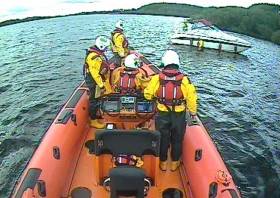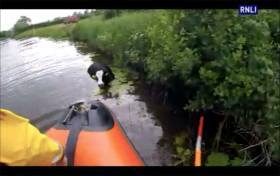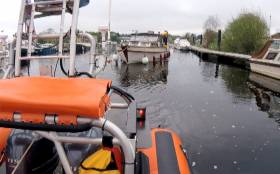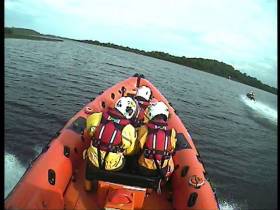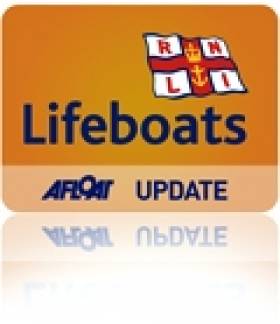Displaying items by tag: Carrybridge
#RNLI - Carrybridge RNLI’s inshore lifeboat and rescue water craft launched to assist a 23ft cruiser which had run aground close to the Share Centre on Upper Lough Erne yesterday evening, Sunday 5 August.
Winds were south-westerly Force 2 with good visibility and cloudy skies when the Carrybridge lifeboat crew were requested to launch by Belfast Coastguard at 5.20pm.
Arriving at the casualty vessel, the lifeboat crew found the cruiser aground and all four people on board to be safe and well.
On assessing the vessel, the volunteer crew found its mean of propulsion had also become damaged when it grounded.
After three of the casualty vessel’s crew were taken on board the lifeboat and transferred to the Share Centre, a tow line was set up with the assistance of the rescue water craft and the cruiser was refloated before being towedd back to its mooring at the Share Centre with its remaining crew member.
It was the second callout for Carrybridge RNLI over the weekend. On Saturday evening (4 August), the inshore lifeboat and rescue water craft launched to a 16ft rowing boat which was adrift in the main navigation channel.
The rowing boat had broken free from its moorings and drifted half a mile upstream from Carrybridge. The vessel was taken under tow by the lifeboat back to its own private mooring.
Speaking following these callouts, Carrybridge RNLI lifeboat operations manager Tom Bailey said: “As we continue to enjoy the good weather, we would remind all boat users to respect the water, plan your passage before setting out, and take particular care whilst navigating. Should you get into trouble, call 999 or 112 and ask for the coastguard.”
#RNLI - Friday 13 July was an unlucky one for a 26ft sports cruiser with engine trouble close to Naan Island on Upper Lough Erne.
Carrybridge RNLI’s inshore lifeboat Douglas Euan & Kay Richards launched at 3.23pm yesterday to the cruiser which had six on board, all found to be safe and well.
After a towline was set up, the lifeboat took the casualty vessel back to Knockninny Jetty and was set to return to station within an hour.
Speaking after the callout, Carrybridge RNLI lifeboat operations manager Tom Bailey said: “As we enjoy this current spell of good weather, we would remind all boat users before going afloat to carry out regular checks of their vessels.
“Also now that the summer holiday season is in full swing, we would ask all users to enjoy themselves but also to respect the water whilst out on the lake.”
Carrybridge Lifeboat Rescues Cow In Distress
#RNLI - Just two days before Carrybridge RNLI’s new inshore lifeboat had its naming ceremony, boat and crew launched to assist a cow that had fallen from a steep bank on Upper Lough Erne.
The lifeboat and rescue water craft launched at 3.30pm on Thursday afternoon (7 June) arrived to the cow and its owner, who had been trying to recover the animal from the Arney River without success.
Weather conditions had southerly Force 2 winds, with good visibility and cloudy skies.
After speaking with the farmer, the volunteer crew kept the animal close to the bank and helped to steer the cow towards a part of the bank where it would be able to get out.
After some careful coaxing, the cow was assisted in getting out of the river by the crew and the farmer’s family. The crew were thanked by the owners and the lifeboat and rescue water craft departed the scene at 4.14pm.
Then on returning to station, the RNLI crew were requested to aid a vessel which had broken down nearby. The crew assisted in towing this boat back to its private slipway.
“We are always happy to help the local community in situations where there is risk to both the public and animals,” said Tom Bailey, lifeboat operations manager at Carrybridge RNLI.
“We also advise everyone working close to the edge of water to take the necessary precautions. In this instance we were delighted that the cow was able to be recovered without injury.”
Elsewhere, Enniskillen RNLI launched yesterday afternoon (Saturday 9 June) to assist a 23ft Bayliner that has lost engine power at the entrance into the River Erne which leads to Belleek.
The charity’s inshore lifeboat Joseph and Mary Hiley and rescue water craft arrived at the casualty vessel which had three people onboard, all of whom were safe and well.
The volunteer crew set up a tow to the lifeboat and towed the vessel to Aughinver.
Speaking following the callout, Enniskillen RNLI helm Aidy Kelly said: “It was a very successful recovery with our crew using the benefits of their winter training to recover the vessel and all onboard safely to Aughinver.”
#RNLI - Carrybridge RNLI’s inshore lifeboat and rescue water craft (RWC) launched at 1.51pm yesterday afternoon (Sunday 13 May) following a request by Belfast Coastguard to assist a 35ft cruiser with four on board which was aground about a mile west of Knockninny in Upper Lough Erne, Co Fermanagh.
Weather conditions had south-westerly Force 3 winds with good visibility and part cloudy skies as the lifeboat Douglas Euan & Kay Richards, helmed by Chris Cathcart and with Nigel Carson, Kyle Boyd and Stephen McMaster on board, and the RWC with Garvan Duffy on board, made their way to the casualty vessel, where all passengers were found safe and well.
Once the cruiser was assessed and found to be not taking on water, the lifeboat crew set up a tow line and refloated the vessel into deeper water.
Following another check for damage, the cruiser was found to be in order and was able to continue on its journey. The lifeboat departed the scene at 2.40pm.
Speaking after the callout, Carrybridge RNLI deputy launching authority Stephen Scott said: “We hope the visitors have a safe onward journey and a enjoyable holiday. As we approach the summer season, we would remind all boat users to respect the water, plan your passage before setting out, and take particular care whilst navigating.”
#RNLI - Carrybridge RNLI’s inshore lifeboat launched yesterday morning (Sunday 6 May) following a request by Belfast Coastguard to assist a 37ft cruiser taking on water on the lough near Belturbet, Co Cavan.
The lifeboat Douglas Euan & Kay Richards, with helm Chris Cathcart, David Reid, Kyle Boyd and Colin Beacom on board, launched at 7.28am from Upper Lough Erne in Co Fermanagh and arrived shortly after in Belturbet.
Winds were southerly, Force 1 and visibility was good with sunny skies.
The lifeboat crew located the casualty vessel moored alongside the public jetty, but still taking on water. Belturbet Fire and Rescue Service were also in attendance. The owner and his dog were unharmed.
The RNLI volunteer crew set up their salvage pump, and started to pump the water out of the casualty vessel. Once the water level started to lower, the access point of the water was located and a temporary seal put in place.
The casualty vessel was then pumped out dry, and the lifeboat towed it to the public slipway where it was beached to avoid it sinking. The lifeboat departed the scene at 9.40am.
Following the callout, Cathcart said: “The crew were glad to be able to assist the owner this morning with his vessel, and hope he continues to have an enjoyable holiday.”
Much earlier on Sunday, the Portrush all-weather lifeboat crew in Co Antrim happened upon a casualty on land after a callout was stood down.
Three volunteer crew — Karl O’Neill, Jason Chambers and Ben Durrant — were returning home after the 1.40am call when they discovered a man who had fallen and had suffered significant injures to the face.
The crew dialled 999 to request assistance. O’Neill, who is also an RNLI lifeguard supervisor, had his responder bag to hand and was able to administer first aid to stop the bleeding from the casualty’s face. Durrant then took the casualty to the local emergency department for further treatment.
Keith Gilmore Portrush RNLI lifeboat operations manager, commented: “Once again our volunteer crew have shown that the skills and training they have received as lifeboat crew members can be applied to assist in any situation.
“I am very proud that the men on their way home at 2am stopped to help a member of the public who was obviously injured and in distress. We wish him a full recovery.”
First Call For New Carrybridge Lifeboat To Capsized Canoeists
#RNLI - Carrybridge RNLI’s new B-Class Atlantic 85 lifeboat Douglas, Euan & Kay Richards launched on its first callout yesterday afternoon (Wednesday 27 December 2017) along with the station’s rescue water craft.
The volunteer lifeboat crew based on Upper Lough Erne were requested to launch at 2.31pm following a report from Belfast Coastguard of two people in the water near the old boat house at Crom Estate after their Canadian canoes capsized.
Helmed by Thomas Graham with crew members David Reid and Kyle Boyd, the new lifeboat made its way to the scene along with the rescue water craft helmed by Chris Cathcart and crewed by Adrian Quigley.
Weather conditions at the time were overcast with Force 4-5 winds and fair visibility. The Northern Ireland Ambulance Service was also in attendance.
As the RNLI volunteers arrived on scene at Crom, a member of the public informed them that the man and woman who came off the canoes had managed to swim ashore with the assistance of two members of the public who had entered the water to assist them. The canoeists were suffering from signs of hypothermia and were being warmed in vehicles.
The RNLI crew secured their vessels and made their way to the casualties as members of the ambulance service arrived on scene. The two casualties were transferred to the ambulance with the assistance of the RNLI crew where they received casualty care treatment.
Speaking following the callout, Carrybridge RNLI helm Thomas Graham said: “The water is very cold at this time of year and the casualties had been in the lough for about five minutes after coming out of their canoes and making their way back to the shore. Thankfully they made it safety ashore and received treatment.
“We would recommend if going afloat in this time of year in any canoe, that lifejackets and drysuits are worn to help protect against the cold waters, and that people also carry a means of communication such as a VHF radio or mobile phone to raise the alert should they get into any difficulties.”
The Douglas, Euan & Kay Richards went on service early last month, replacing Duckhams 2001 which has been used to rescue people on Lough Erne in County Fermanagh since 2015.
Carrybridge Lifeboat Rescues Cruiser From Rocks
#RNLI - Carrybridge RNLI’s lifeboat and rescue water craft were requested on Wednesday afternoon (23 August) to launch to a 30ft cruiser which had encountered fuel issues and drifted onto rocks on Upper Lough Erne.
The casualty vessel, with two persons on board, was located around a mile north of the Crom Estate in Co Fermanagh. The RNLI crew assisted in refloating the vessel and towed it back to Geaglum Jetty.
Elsewhere, Clogherhead RNLI in Co Louth launched on the same afternoon in response to a report that a razor clam fishing boat was sinking off Drogheda Bar.
While the lifeboat was en route to the scene, the two fishing crew were rescued by the Drogheda Pilot Boat, taken upriver and transferred to an ambulance.
The lifeboat travelled at full speed to the scene and on arrival found the casualty vessel almost totally submerged. The RNLI crew managed to locate the boat's EPRIB among the debris.
Carrybridge RNLI in County Fermanagh launched this morning in response to a report of a gas explosion on a vessel at a marina in Carrybridge.
The volunteer lifeboat crew was requested to launch both their inshore lifeboat and Rescue Water Craft at 11.08am following the report from Belfast Coastguard that the explosion had happened on a vessel thought to have one person onboard.
The lifeboat helmed by Chris Cathcart and with crew members Adrian Quigley and Nigel Carson onboard launched immediately along with the station’s Rescue Water Craft with Kyle Boyd and Jen Bailey onboard.
Weather conditions at the time were overcast with light winds and fair visibility.
With initial unconfirmed reports that someone may be on the vessel, a full search was requested with Carrybridge RNLI as on scene commander.
The Northern Ireland Fire and Rescue Service, Ambulance Service and the PSNI attended while the Irish Coast Guard Rescue 118 helicopter from Sligo was also tasked.
During the search, the lifeboat learned that a man who had been on the boat had been removed from the scene prior to the emergency services arrival by a member of the public from the shoreline and was taken to hospital for further treatment.
Following the completion of a full search, all agencies were stood down.
Speaking following the call out, Carrybridge RNLI Helm Chris Cathcart said: ‘We would like to wish the man who had been on the boat well following what must have been a frightening experience for him. We would also like to commend the member of the public on the shore who came to his assistance. Today’s call out was a good example of multiple agencies responding well together.
‘We would remind all visitors to the lough during the boating season to ensure they do regular checks on their vessels so everything is in working order. When on the water, always wear a lifejacket and always have a means for calling for help. Always check the weather and tide times and make sure someone ashore knows where you are going and who to call if you don’t return on time. Should you get into difficulty, call 999 or 112 and ask for the Coastguard.’
#RNLI - Carrybridge RNLI attended three different incidents – one involving a fire – on Upper Lough Erne this past Saturday (11 June).
The inshore lifeboat and rescue wafer craft were initially tasked to a burning vessel at 6.08pm, two miles north of Belturbet. Both Belturbet and the NI Fire and Rescue Service were in attendance.
The four people onboard were safely removed from the boat by a passing vessel and brought to shore. The 25ft Bayliner later burnt itself out and sank into shallow waters close to the shoreline.
The volunteer crew were then tasked by Belfast Coastguard to a boat with engine problems 1.5 miles from Knockninny. The sports cabin cruiser and its four passengers and their dog were brought to safety at Knockninny Marina.
The third tasking saw Carrybridge RNLI going to a vessel that ran out fuel close to the Share Centre. The 22ft vessel and its passenger were brought to safety of the Share Centre Marina.
The lifeboat and rescue craft returned to station at 9.15pm.
Speaking following the callouts, Carrybridge RNLI helm Chris Cathcart said: "The crew of the burning vessel did the right thing by alerting the coastguard straight way when their vessel went on fire.
"They made sure they had their lifejackets on and evacuated their vessel to another passing vessel as soon as possible."
Cathcart also commended the crews of the further two vessels the lifeboat assisted for their quick thinking when they found themselves in danger.
"The importance of alerting the coastguard as soon as possible in all cases help saves lives and prevented the situation from developing into something more serious on all our callouts."
The busy evening for the volunteer crew was in the first weekend of the RNLI’s summer campaign #RespectTheWater that targets accidental drowning along Northern Ireland’s coastline and inland waterways.
Respect the Water urges the public to watch out for the key dangers that can catch people out in or near the water. The campaign which will run throughout the summer months aims to highlight the risk of accidental drowning when people are near the water’s edge while encouraging safer behaviour both in and around the water.
#RNLI - The RNLI’s first permanent inland lifeboat station is now complete and fully operational on Upper Lough Erne in Co Fermanagh.
After been housed in temporary accommodation for 13 years, Enniskilllen RNLI volunteers were handed the keys to their new building in Carrybridge this week.
The modern purpose-built lifeboat station is located close to the lough to allow for an efficient launch of its inshore lifeboat and rescue water craft.
The station, which also houses the associated launching tractor and equipment, full crew changing facilities, a workshop, office and training room, will be officially opened later this year.
First announced nearly two years ago, the build took little over a year to complete was carried out by the Omagh based Woodvale Construction Company and handed over to the RNLI last Wednesday 25 March.
The building is designed with a heating system which allows the heat to be drawn from the ground and produced inside, keeping the temperature at an ambient 15 degrees Celsius. The excess is used to heat the water for showering, washing-up and cleaning the vessels. Solar panels on the roof will also generate electricity for the station's needs.
In order to facilitate the project, the local community helped the charity raise £60,000 towards the cost, which will now help the RNLI’s 40 volunteers based at Enniskillen to continue to save lives on Lough Erne.
In 2001, Enniskillen became home to the RNLI’s first inland lifeboat station based on Lower Lough Erne. Due to the overall size and complexity of the lough and its high leisure usage, the decision was taken by the RNLI in 2002 to base a second lifeboat on the Upper Lough at Carrybridge that would work in conjunction with the original lifeboat station on the Lower Lough at Killadeas.
With two bases, two inshore lifeboats and two rescue water craft, the station has since proved to be one of the busiest in Ireland.
Last year alone, Enniskillen RNLI launched 59 times, bringing 57 people to safety. Some 32 of those services were carried out in the dark while the crew spent 262 service hours on the water.
Speaking following the handover of the new building, RNLI divisional technical manager Derek Potter said he was delighted that the station was now complete.
"From the outset, we wanted to build a modern station with full crew facilities with areas for the crew to change and train and space to keep their lifeboat and rescue water craft and lifesaving kit safe," he said.
"We now have those facilities and are very happy to be in a position to take over the new lifeboat station and are delighted with both the design and quality of the building."
Enniskillen lifeboat operations manager Davey Robinson added that the new station was what the crew deserved.
"The new station is a testament to the RNLI’s commitment and dedication to the community here locally and a credit to our crews efforts in continuing to bring people to safety on Lough Erne," he said.
"Our volunteers had an opportunity to be shown around their new station this week and they are overwhelmed with the structure and facilities that they now have when they come together for callouts and training.
"We would like to thank everyone who has helped us to get to this stage including all those who donated, organised or participated in any fundraising activity."


























